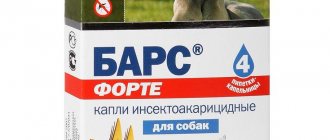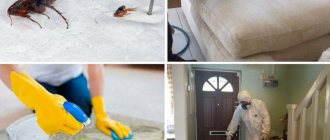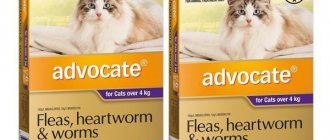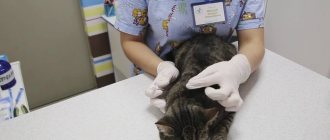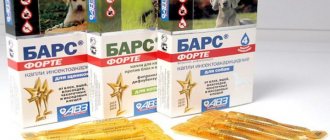How do tick and flea drops work?
How drops against ticks and insects work depends on their main substance. Most often, insectoacaricidal preparations for the withers against ixodid ticks and fleas, that is, containing poisons, are on sale. Unfortunately, it is problematic to effectively protect an animal from parasites using another method, for example, using natural repellents. However, in some cases it is necessary to use natural products (for pregnant and lactating females, weakened animals and kittens with puppies).
Repellent drops are designed to repel insects with their unpleasant odor. Most often, fleas and ticks do not like the smells of geranium, mint, lavender, eucalyptus, and citrus. Despite the fact that most classical veterinarians are skeptical about such repellers, there are veterinarians who consider this the safest protection and at the same time quite effective.
Insectoacaricidal drops for ticks and fleas contain poisons that act on the nervous system of parasites, killing them. Such substances are divided into two main groups:
- contact (they are almost not absorbed into the cat’s blood, but are distributed throughout the fatty lubricant, killing even before the bite upon contact with the paws);
- systemic (can be absorbed into the cat’s blood or distributed throughout the fatty lubricant of the skin, but they act only at the moment of the bite, since the poison must enter the stomach and blood of the parasite).
The following insectoacaricidal substances are approved for use in cats. Before purchasing a drug, be sure to look at its ingredients to make sure it is safe.
| SUBSTANCE | DESCRIPTION |
| Tetrachlorvinphos | This insecticide affects insects before they bite, preventing irritation and allergic reactions to saliva. Tetrachlorvinphos is of low toxicity to mammals, but still frequently causes intolerance reactions in cats. Therefore, we did not include drops based on this poison in the rating. |
| Diazinon | The poison almost does not enter the blood, but is distributed with sebum throughout the body. Diazinon acts on insects as a poison and as a repellent, that is, it poisons and repels. You don't need a bite for it to work. As a rule, fleas and ticks react to the drug even before this. The insect's nerve impulses are disrupted and paralysis occurs. |
| Fipronil | An insecticide with a nerve paralytic effect. Active against many types of insects that have already developed resistance to other poisons. The substance is of low toxicity to mammals. It is almost not absorbed into the blood if applied to the skin, but is distributed throughout the fat layer. |
| Phenothrin | It has a neurotoxic effect on mature individuals and larvae. Use is permitted not only for animals, but also in human shampoos. |
| Metropen | Contraindicated in kittens under three months, as well as weakened and exhausted animals. Not recommended for use in pregnant and lactating cats. |
| Propoxur | It has an insecticidal and repellent effect. Ensures complete death of insects. It is moderately toxic for warm-blooded animals: in their bodies it decomposes into non-toxic substances, but the substance almost does not enter the blood, but is distributed over the skin. Ticks often develop resistance to propoxur. |
| Sevin | A broad-spectrum insecticide that does not have the ability to accumulate in the body of warm-blooded animals. This substance is moderately toxic for cats and humans. But this insecticide can have a local irritant effect, so you need to monitor skin reactions. |
| Permethrin | Not recommended for use, because toxic to cats. The cat's liver cannot detoxify the body from this poison, and as a result, problems with the nervous system develop: the cat loses coordination, and seizures may begin. The death of the animal may occur. |
| Imidacloprid | A new generation insecticide belonging to the class of chloronicotinyls (nitroguanidines). The mechanism of action is based on blocking the functioning of the insect's nerve cells, which leads to paralysis and death. Due to a completely different mechanism of action compared to pyrethroid, carbamate or organophosphorus compounds, the drug is effective against insects resistant to the above groups of insecticides. |
| Fluralaner | Insectoacaricide. Paralyzes and kills insects and ticks. Belongs to a new class of poisons. Quite effective against blood-sucking insects. There is no resistance to it yet. |
| Moxidectin | A fairly well-studied substance, used since 1980. Active against helminths and skin mites. Paralyzes and kills parasites. |
| Selamectin | Works against nematodes, mites and insects. Normally tolerated by cats of different breeds. Refers to moderately hazardous substances. |
| Sarolaner | A very effective new substance against fleas and ticks. It is considered quite safe for mammals (hazard class 4). |
Features of protection of pregnant females and kittens
For pregnant and lactating females, kittens, and weakened animals, there are special products of all types. These are drops (Clandestine Junior), and sprays (Fiprist), and shampoos (Clandestine). Each of them is designed for a specific age of the animal, but kittens under 2 weeks old cannot be treated with any means. At an older age, if the kitten has not yet been weaned from its mother, after treatment it must be isolated from the female for some time in order to avoid licking the drug.
The best anti-flea drops: rating
We present to your attention our rating of anti-flea drops for cats. The rating of drops against ixodid ticks is presented below. The fact is that manufacturers, as a rule, focus specifically on fleas and do not always include components against ixodid ticks. After all, most cats stay at home.
Only high-quality drugs are presented below. We did not include cheap products in the rating. But you need to understand that even the best drops can “break through”, that is, a tick can bite an animal and not die, but these cases are rare, and therefore, by choosing a good product, you minimize the risk that it will not work.
When choosing a drug, please note that many drops are available in several versions for different weight categories. It is very important to choose the right category.
Article continues after advertisement
Hartz Ultra Guard
The American company Hartz has released Ultra Guard drops for withers, which exist in variations for dogs and cats. The variation for cats works against fleas and their larvae. The active ingredient is methoprene.
BUY IN UKRAINE
BUY ON AMAZON
Stronghold
Stronghold drops from Zoetis are available in several variations. There are variations for cats and dogs that destroy ticks (but not ixodid ticks) and insects, as well as some types of helminths. Active ingredients: selamectin and sarolaner. The dosage varies depending on the weight of the animal. You can also choose a separate type of drops that are suitable for kittens and puppies from six weeks of age. Thus, when choosing a specific modification, they take into account the weight and age of the animal, as well as the biological species (cat or dog).
BUY IN RUSSIA
BUY IN UKRAINE
Advantage
Advantage anti-flea drops from the German company Bayer for cats contain a fairly effective and safe substance, imidacloprid. It acts quickly: if there is already an infection, imidacloprid destroys fleas parasitizing the animal within 12 hours. The active substance is also interesting because it destroys flea larvae. Not all poisons can do this. The drug is approved for kittens from 8 weeks. Suitable for pregnant and lactating women.
BUY IN RUSSIA
BUY IN UKRAINE
BUY ON AMAZON
Article continues after advertisement
Advocate
And again the German company Bayer. Advocate drops are available for dogs and cats (two variations). They are effective against insects, ticks (not ixodid!) and helminths. The active ingredients are imidacloprid and moxidectin. If imidacloprid is a contact drug against insects, including fleas, then moxidectin penetrates into the blood of cats and acts on internal parasites. As you have already noticed, many Bayer drops have a wide spectrum of action and are good for those owners who want to prevent and treat both helminthiasis and external parasitic diseases in one fell swoop.
BUY IN RUSSIA
BUY IN UKRAINE
Instructions for use
Drops against blood-sucking fleas are easy to use. It is necessary to adhere to the following algorithm of actions:
- lay the cat on its stomach, stroke it, calm it down, but at the same time hold it well;
- spread the fur on the withers and (or) back of the head - places inaccessible for licking;
- Apply the concentrated solution and gently rub it into the skin.
No preliminary preparation is required. But veterinarians recommend not bathing your cat for several days before the procedure. A sufficient amount of sebum will accumulate on the surface of the epidermis, which perfectly absorbs the insecticide.
Important! The cat should not have any microtraumas in the areas where the flea medication is applied - scratches, cracks, damage from bites of other animals. Otherwise, the insecticide will penetrate the bloodstream, which may cause side effects.
The best drops against ixodid ticks and fleas for cats
If you want to organize protection against both fleas and ixodid ticks at the same time, take a look at the following drugs. If desired, they can also be used as protection against fleas only.
Frontline
The French company Merial produces Frontline drops in several versions: for cats, small dogs, medium dogs and large dogs. They differ in active ingredients and dosages. For cats, the active ingredient fipronil is used - relatively safe and very effective. However, many counterfeits are now sold for this product.
BUY IN RUSSIA
BUY IN UKRAINE
BUY ON AMAZON
Broadline
Broadline drops from the French manufacturer Merial are distinguished by a wide spectrum of action due to the fact that they contain four active ingredients: fipronil, S-methoprene, eprinomectin and praziquantel. The drops provide protection against roundworms and tapeworms, ixodid ticks, fleas and their immature stages, as well as other insects. Can be used from seven weeks of age. Fipronil and (S)-methoprene are distributed throughout the skin and hair, almost without being absorbed into the bloodstream. These substances are designed to protect against external parasites for 42 days. Eprinomectin and praziquantel are absorbed through the skin into the blood and kill helminths present in the body. The advantage of the drug is that it also acts against dirofilariasis - in some regions this is relevant.
BUY IN RUSSIA
BUY IN UKRAINE
Article continues after advertisement
Inspector Total K (Inspector Total K)
Inspector drops from the German company Neoterica GmbH have the same wide spectrum as the previous drug. Contains fipronil and moxidectin as active ingredients. It is possible to treat kittens and puppies from seven weeks of age.
BUY IN RUSSIA
BUY IN UKRAINE
Bravecto (Bravecto)
Bravecto flea and tick drops are available for cats and dogs. For cats, the substance used is fluralaner. It is absorbed into the animal’s blood and spread throughout the body. It acts systemically on parasites. Active for 12 weeks.
BUY IN RUSSIA
BUY IN UKRAINE
What are the dangers of blood-sucking ixodid parasites for cats?
Bloodsuckers of the ixodic family, in addition to piroplasmosis, which does not threaten cats, actually transmit a lot of vector-borne diseases - about 200 forms! Ticks are carriers and distributors of various pathogens, which, when they pierce the skin layer with tick saliva, enter the victim’s body:
- pathogenic bacteria;
- dangerous viruses;
- parasitic rickettsia;
- harmful protozoa;
- helminths that undermine health.
In addition to these misfortunes, ixodid bloodsuckers are dangerous for cats by transmitting dermatobiasis, a dangerous infection caused by the penetration of gadfly larvae under the skin and causing severe suppuration. Any antibiotic is powerless against such subcutaneous abscesses - the pathogen is removed only surgically, cutting out along with the infiltrate. And then numerous, difficult to heal cuts remain along with scars that disfigure the pet.
But even with piroplasmosis, not everything is smooth for cats! In recent years, there have been cases of registration of cats in which Babesia, the causative agent of this deadly infection for animals, was detected in their blood. And although this is isolated data, it doesn’t hurt to be wary. This infection is not difficult to treat, and you can choose an effective drug, the main thing is to recognize the disease in the first 2 - 3 days, otherwise irreversible processes begin.
You should not miss the toxicity of the saliva of some ticks for cats, which sometimes causes specific poisoning:
- stiffness of the cat’s movements due to pain in muscles and joints;
- lethargy and refusal to feed;
- vomiting and stool disorders;
- increased body temperature in a cat;
- the appearance of a rash with or without itching;
- inappropriate pet behavior.
In many cats, mite saliva causes allergy attacks, which manifest themselves differently in each cat, from swelling and shortness of breath to dermatitis and even the appearance of bald spots. To neutralize allergic manifestations, any antihistamine is used, and in the presence of complications, symptomatic therapy is added.
How to apply drops against ticks and fleas: instructions
Drops for animals against ticks and fleas are produced in the form of special pipettes, which contain one dose of the drug. That is, when treating a cat, you need to empty the entire pipette. One package usually contains 1-3 pipettes.
One treatment is enough for 4 weeks, but it is better to play it safe and drip once every 3 weeks during the period when ticks and fleas are active, that is, in the warm season. The expiration date is always indicated on the packaging. But you need to take 1 week away from it for the protection to work for sure throughout the entire period of use, because Every day the substance is slowly losing its strength.
Before applying the drops, do not bathe the cat for 2-3 days, so as not to wash off the grease. When applied to oil-free skin, the drug can penetrate into the blood, which is undesirable. In addition, it is distributed throughout the body precisely thanks to fatty lubrication, and if it is not there, then the desired effect will not be achieved. After application, you also need to wait 2-3 days and only then, if necessary, bathe the animal.
How to apply tick and flea drops? Very simple. Cut the neck of the pipette and pour it onto the withers in one fell swoop. A greasy stain forms at the treatment site, which will disappear after a few days as the drug is distributed over the skin. Accordingly, if your animal is about to have a show, you need to apply the drops at least a week or two before the show.
The drug is applied to the withers to prevent the animal from getting drunk and poisoned. If the cat managed to do this, vomiting, diarrhea, depression, fever, and, in general, all the negative reactions that should have occurred with the parasite that attacked it are possible. Very rare, but there are deaths. In this case, you need to urgently contact a veterinarian so that he can treat your pet. If suddenly your cat reaches the place where the drops are applied, you can put a special collar on it for one day, while they are absorbed, which is sold in veterinary clinics and pet stores.
Also, even with proper use, individual reactions are possible. As a rule, they appear in the first 15-40 minutes after applying the drug. These include vomiting, diarrhea, sneezing, watery eyes, and sometimes difficulty breathing. The most common reaction is itching and redness of the skin. In rare cases, hair falls out at the application site. If an individual reaction occurs, you must thoroughly wash off the drug with shampoo and never use it again. Choose your next product based on a different active ingredient.
Some cats, after applying the drug, despite the absence of allergies, still begin to itch. If such a reaction is not accompanied by other negative consequences and goes away within a few hours, leaving no irritation or areas of baldness, then the drops do not need to be washed off. This reaction is within normal limits. But this is only if the animal completely stops itching after a few hours. In any case, before purchasing and using any drops, be sure to carefully read the instructions!
If there are several cats in the house, after applying the drops it is necessary to keep them in different rooms for 24 hours until the drug is absorbed. This is only necessary if your cats have a habit of licking each other.
Symptoms
Fleas in cats cause a natural urge to itch. Parasites bite through the skin, feed on blood and can spread some dangerous infectious diseases. Fleas are especially active when it gets warmer.
Watch out for the following symptoms:
- Changes in behavior.
A cat affected by fleas begins to behave restlessly, licks the fur intermittently and harshly, chews the skin, often itches, especially in the head area, and may suddenly jump up while walking slowly or immediately after sleep. - Deterioration of the pet's external condition.
Pay attention to the skin: it may be irritated and red, especially in the area of direct bites. On the neck and along the back you can see pinpoint areas with slight redness, covered with dried crusts on top. Often, characteristic bald patches appear at the site of the bites. - The appearance of worms in feces.
Fleas can infect your cat with helminths. Most often this is a cucumber tapeworm, or dipylidium (lat. Dipylidium caninum). Segments of the parasite's body that resemble cucumber seeds can often be found in the feces of infected adult cats and kittens. In this case, antiparasitic treatment should be comprehensive, including the destruction of helminths. - Decreased activity and general weight loss.
A cat with parasites may be lethargic or nervous. Her appetite increases or decreases depending on the degree of infestation, her overall body weight decreases, and the condition of her coat worsens, becoming dull and no longer shiny. - You may not see the fleas themselves, but it is quite possible to detect their feces in the form of small black lumps resembling poppy seeds.
If you have any doubts that your cat has fleas, it is recommended that you contact your veterinarian. Itching and rashes on the skin can be symptoms of other diseases, such as allergies.
Do I need to secure myself by other means?
Many owners, in addition to applying tick and flea drops to the cat’s withers, prefer to add some other means to them, for example, collars or sprays. Cats, as a rule, do not need double treatment. But in dogs such a need arises, because... they walk more actively and often visit places where ticks and fleas accumulate. Cats that are on their own or actively walking with their owners may also need double protection.
Typically, drops on the withers are combined with a collar or spray. If they are combined with a collar, then the animal is first treated with drops, and after about a week the collar is put on. If drops are combined with a spray, then the drops are applied first, and the spray is used only before a walk.
However, the owner must understand that there is no 100% guarantee that even the best remedy will not “break through”. Ticks and fleas are increasingly adapting to poisons. Therefore, no matter what protection you use, after each walk the animal must be checked for ticks. If you notice a tick, it must be removed immediately.
Rate and share!
Shampoos
They can be used when the animal is already infected. The pet must be thoroughly soaped, soaking the entire fur with foam, avoiding contact with the eyes and ears, leave for ten minutes, after which the shampoo should be rinsed off well.
The most popular products: Rolf Club, Fitoelita, Biovax, Mr. Kiss, Bio Groom. All shampoos have approximately the same effect. It is important to choose the right product. Be careful: after treatment, the cat will lick itself and may receive a small dose of the drug.
Rules for using drops
The instructions for using the drops clearly and clearly explain the features of using the product.
The first thing to remember is that the drug is applied to dry, but in no case to wet or damaged skin. The composition is distributed pointwise on the withers, which avoids the animal licking the drug. The cat should not be washed for 3 days after treatment. It is also not recommended to wash your pet 2 days before using the product. Reapply the drug only after its protection period has expired.
If the treatment is carried out for the purpose of treating ear scabies, then the medicine is dripped directly into the ears. Before the procedure, you need to carefully clean your ears from accumulated plaque, dirt, and purulent exudate using a cotton swab dipped in hydrogen peroxide. Then drip the solution into both ears, even if there are no signs of otodectosis in the second. After this, massage the auricle in a circular motion. The remaining drops are applied to the skin in the back of the head for prevention.
To avoid undesirable consequences, it is necessary to use insecticides in accordance with the instructions and comply with the permissible amount of solution used.


